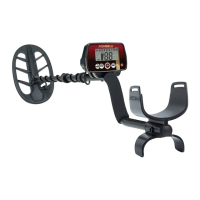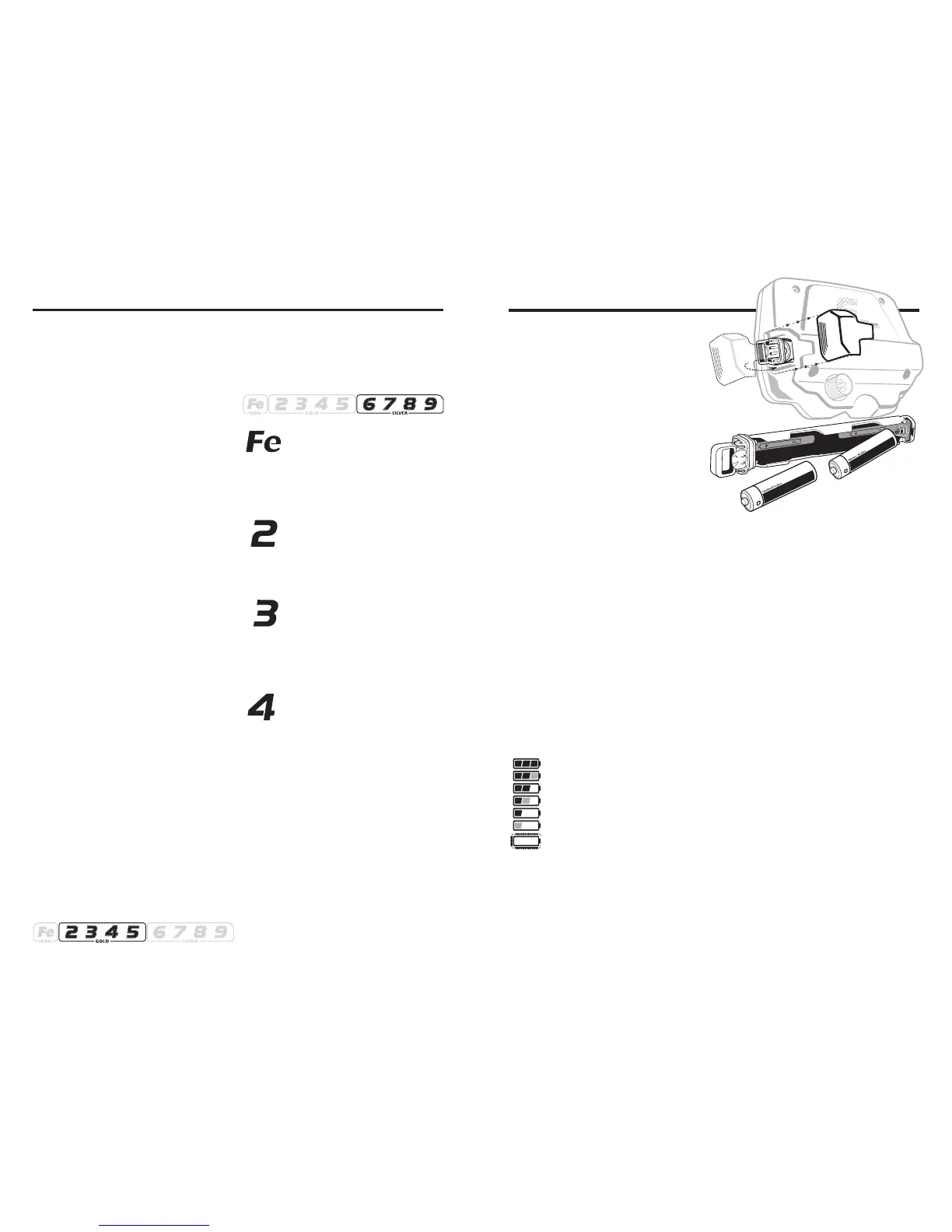718
DEPTH & TARGET DISPLAY
READING THE DISPLAY
The display shows the PROBABLE
identification of the metal detected, as
well as its PROBABLE depth.
The detector will register a target upon
each sweep of the searchcoil, when a
buried target has been located and
identified. If, upon repeated passes
over the same spot the target
identification reads inconsistently, the
target is probably a trash item. With
practice, you will learn to unearth only
the repeatable signals.
Target-ID numbers, as indicated on the
Coin Reference chart (page 17), are
highly accurate when those items are
detected. However, there are many
other metallic items that will register
within these groups, so identification is
not always accurate. Multiple targets
in close proximity to each other,
especially if one is above the other in
the soil matrix, can display non typical
ID and Depth, or “mask” out the
deeper target altogether. The greater
the distance between the target and
the searchcoil, the less accurate the
target identification.
Depth indication in the Pinpoint mode
is accurate on coin-sized objects as
defined in the category groups, but it
too can be inaccurate if multiple targets
of varying depth and conductivities are
in close proximity of each other.
GOLD TARGETS Gold objects will
generally register in the “GOLD” group
with smaller items in groups 2 & 3 and
larger items in groups 4 & 5. Gold
flakes will register under iron.
SILVER TARGETS: Silver objects will
register in the “Silver” group, A U.S.
dime will ID in group 6, a US quarter in
group 7, a U.S. half dollar in group 8
and a U.S. dollar in group 9.
1-19. All sizes of iron objects
will register on the far-left side of the
scale. This could indicate a
worthless item such as a nail, or a
more valuable historic iron relic.
20-29. Aluminum foil, such as
a gum wrapper, will register as foil. A
small broken piece of pull tab may
also register here.
30-39. U.S. Nickels, most
newer pull-tabs from beverage cans,
the type intended to stay attached to
the can, will register here. Many gold
rings will also register here.
40-49. Many medium-sized
gold rings also register here. A few
newer pull-tabs will also register
here. Many gold rings will also
register here. S-CAP: Older screw
caps from glass bottles will register
here. Large gold rings, like a class
ring, could also register here. Some
non-U.S. coins of recent vintage will
also register here.
The detector requires two AA batteries.
We recommend ALKALINE batteries
(not included).
Do not use ordinary “Zinc
Carbon” batteries.
Do not use “Heavy Duty” batteries.
Rechargeable batteries can also be
used. If you use rechargeables, we
recommend using a “Nickel Metal
Hydride” rechargeable battery. The
battery compartment is located on
the right side of the Control Housing.
Both batteries should be installed with
the negative terminal down.
Remove battery tube:
1. Slide the battery door off.
2. Extend the handle on the battery tube (with your finger or by using the tab
on the battery door to pry the handle into the extended position)
3. Pull on the handle to remove (do not use the battery door tab to pull the tube
out of the control housing, as this may cause damage to the battery door)
To install battery tube:
1. Position the handle on the battery tube in the lowered position.
2. Firmly push down on the battery tube, until the battery tube handle is
flushed with the housing. (The battery tube will only insert one way, with the
brass contacts facing towards the display and the hinged side of the handle
towards the back.)
BATTERY LIFE
Expect 25 to 30 hours of life from 2 AA Alkaline batteries. Rechargeable
batteries provide about 15 hours of usage per charge. Backlight increases
power consumption and decreases battery life, with significant power drain at
maximum brightness.
BATTERY INDICATOR
The battery icon has three segments plus an outline segment. The amount of
battery voltage for two ALKALINE batteries is indicated as follows:
All segments black: >2.8 volts
Right segment grey, other two black: >2.6 volts
Right segment off, other two black: >2.4 volts
Right segment off, mid grey, left black: >2.2 volts
Right and mid segments off, left black: >2.0 volts
Right and mid segments off, left grey: >1.8 volts
All segments off, outline flashing: < 1.8 volts
It is recommended to change the batteries when you see the one black segment.
SPEAKER VOLUME AND BATTERY CHARGE
You may notice the speaker volume drop while one battery segment is
illuminated. With the outline flashing, low speaker volume will be very apparent.
BATTERY DISPOSAL & RECYCLING
Alkaline batteries may be disposed of in a normal waste receptacle or
recycled. Other battery chemistries should be recycled.
BATTERIES

